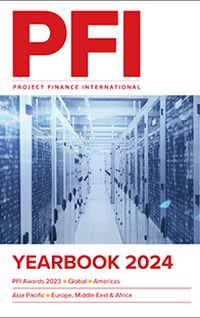There has been a growing surge in demand for data centres, and structured financings to go with them. The structure, a mix of energy and telecom asset, is evolving and has become extremely important in our world of data and AI. By Minerva Lau.
At this year’s PFI conference on Financing Energy Projects in Asia (FEPA), a new sector – data centres – was introduced. Data centres are relatively new but demand in the Asia-Pacific has been growing in the last few years. It is expected to grow exponentially in the next five years, driven by high levels of technology adoption, 5G rollout, data localisation, and growth of internet-based companies.
Market activity
The members of the data centre panel talked about three broad markets for data centres: Tier 1, or the largely developed and fairly large markets such as Singapore, Japan, Australia, India, and China; Tier 2, or the up-coming markets such as Indonesia, Malaysia, the Philippines, and Thailand; and Tier 3, or the frontier markets such as Vietnam, where “there is a lot of underlying interest and certain factors which make it a very interesting market”, said Vinesh Gupta, SMBC head of digital infrastructure team Asia-Pacific.
Eugene Tan, director, telecom media & technology finance at Societe Generale, agreed that the markets are growing at “extraordinary rates”. He gave two examples – Australia, which is a very developed, tier one market, is looking at almost 500MW of development in next two years. “This is driven by incumbent, established players. Competition is very high over there”, he said.
South Korea, on the other hand, is a tier one developed economy but lags behind Japan and Australia. However, activities have been growing and Tan estimates that about 550MW will be developed in the next three years.
“That market is a bit different. That market is now being entered into by international players. It used to be housed by domestic incumbents.” Tan said and added that the business model there is different. “They do system integrations, they offer data centre services by the site”.
Jean Monson, project finance and ESG finance director at MUFG, explained that there are three key reasons for why the markets are seeing so much activity.
One is related to changes in law, he said, citing Singapore as an example. Over the last decade or so, Singapore has become a key hub for digital infrastructure in the Asia-Pacific region. However, it is a small country with an area that is just about 734.3 square kilometres, and in 2019, it already had some 60 data centres with a footprint of more than 357MW contributing to the global warming. The sector uses more than 7% of Singapore's power supply, which contributes to global warming. Thus, the government announced a three-year moratorium on data centre development. No new data centres were approved but existing projects and expansions were completed during that period.
“When Singapore put the moratorium on, what happens immediately was a spike in interest in Malaysia, and places like Johor, and you also see an interest in Batam, and in Jakarta in Indonesia, and all these places,” said Monson.
The second reason is the surge in activity is data protection, stronger data protection across all countries.
“What that means is that you have to host your citizens’ data within borders. So, localisation of data within borders is, again, a big driver for the offtake of new data centres,” she said and further elaborated citing India as an example.
“When India, for example, introduced their Data Protection Bill in 2017, that meant that you have to store data within India, and it can’t be serviced by foreign cities like Singapore and Hong Kong," Monson said. "Because of that, you have to build your data centre in India, and the same for Malaysia, same for Indonesia, same for Thailand, Vietnam. That causes a spring in data centres in all of these regions.”
The third reason is consumer-driven, demand-led. Monson said everyone has a phone and use it constantly, and there are high performing applications that are “coming on hard and fast” such as AI, ChatGTP, IOT, driverless cars, and other technology that requires high performance, and bringing the applications and the hardware closer to the consumers.
In addition, there are multiple locations and multiple hotspots in one country, which also contribute to the increase in activities. India has Mumbai as well as Hyderabad, Pune, Bangalore and other cities.
Alfred Ng, a partner at Ashurst and moderator of the discussion, added the story of Singapore, which plans to import renewable energy. “The expectation is that a lot of that renewable energy, obviously, will be useful to support the development of the data centre asset class in Singapore. Then, the Singapore-Malaysia story is interesting as well. Malaysia has been (through Johor), supporting Singapore demand for data,” Ng remarked.
Tier 1 vs Tier 2
There was a lot of discussion on the choice of location for a data centre, between Tier 1 and Tier 2 cities. One focus of the discussion was land, as a data centre needs land and it needs space. It also needs fibre connectivity and redundancy, because the “data centre cannot drop. You cannot have any downtime in any shape of form”, remarked Krishna Menon, CFO of AdaniConnex.
He said that Adani is a comprehensive energy solutions provider and treats energy as a service. “So, you have land, you have fibre connectivity, energy as a service, and you also have permissions, literally, permissions, on-ground permissions in terms of the plot of land, the approvals you have before a construction activity can take place. Therefore, these skill-sets are what is driving the decision to be able to put a data centre in place and what location to do it,” Menon said.
“Energy is the key factor which drives, and therefore if you can get energy to a location where there is cheap land resource, and there is fibre redundancy for a data centre, that becomes the decision,” he added.
Menon suggested that to have large data centres between 10MW and 50MW, Tier 2 cities may be the place of choice as Tier 1 cities are “frightfully” expensive. “Tier two cities today are a big opportunity, because they are not congested, there is availability of land, there is great availability and the ability to take your transmission lines down to the retail section and provide there, and you have a renewable energy solution,” he added.
And technical competence is also important, especially in terms of data centre infrastructure management modules. Menon disclosed that Adani has a data centre in a tier two town, Siruseri, as well as in “Noida, which is close to Delhi, but yet away from the place. We are looking at Pune now. So, I think that’s where tier two cities are becoming very attractive today.”
Hyperscale and co-location
There are different types of operating models for data centres, and these are mainly split into hyperscale and co-location (colo). Gupta of SMBC discussed co-location, which is seen as smaller and easier, and usually a contract would be between 1MW and 5MW. It could also be a small hyperscaler of between 5MW and 10MW. Co-location contracts re enterprise businesses, which means their requirements are less than 1MW in most cases and contracts are usually three to five years long. If they are an existing data centre operators, migration comes into focus in a contract.
Gupta discussed hyperscaler contracts which are “what all the bankers love because these are take or pay contract".
“It’s given, it’s fully contracted, it’s long-term tenured contracts, 15 to 20, with a renewable option after the 20th year. Typically, you’re looking at 10MW to 50MW, which means the cashflows which come in, on a full RAM basis are extremely good. These are dollar contracts with an escalation built into them. Therefore, from a construct perspective for a banker, it’s a clean transaction,” Gupta said.
"The only other element which comes in is whether you own the land or not. So, if the land is built in as a lease and it’s a co-lease which co-terminates with the actual data centre contract, it works very well. I think that’s what the bankers love best.”
Financing
Financing data centres has been a bit confusing as different banks use different lenses in treating the new assets. There are different financing structures applied to them based on the contracts linked to the assets.
Monson explained that there are a few “buckets” that it could fall into or a few lenses that it can be seen through. One is project finance, where they are viewed with a cashflow-based lens, and that would be non-recourse.
The second is the corporate bucket. “That’s probably more relevant for operating data centres where you can leverage the cashflows at holdco level. Then, there’s also real estate, where you are monetising from the valuation from them,” Monson said. She added that that there are more developed models that are not seen much in Asia but in the US.
As the market in Asia is still in its nascency, some proof of concept and some test cases will be needed, and as the market matures there will be more diversity, and possible blended or hybrid financing may emerge.
“These financing structures, from our perspective, follow the contractual structures, which is exactly what Krishna was highlighting. And yes, we love hyperscale contracts…" Monson said. "This question I get asked all the time is, ‘Are you financing data centres on a cashflow-based model, or are you doing it as real estate?’ So, when you think about the hallmarks of a project finance transaction, you are thinking about a long-term contract to cashflow from a single, high-quality off-taker. If you use those hallmarks without referencing any asset, that fits the hyperscale structure,” she said.
However, if the data centre is a retail co-location model, it will have shorter contracts of one to three years, or maybe five years, and a diversity of offtakers. “It will get more interesting but also more challenging from a cashflow lens perspective to see how you can model for that, because what you’re doing is moving away from having that visibility and confidence in cashflows, to seeing fluctuation. You’re seeing a diversity in cashflows, you’re also seeing exposure to price and volume, which is what project financiers are terrified of,” Monson said.
Tan of Societe Generale agreed, saying: “You’re absolutely correct to say data centre is a hybrid asset. There’s a real estate lens to it; there’s a project finance lens; and there is also a leverage bankers’ lens. The way we see it is mainly cashflow driven,” he said, and added that the value of a hyperscale contract then is the most bankable to the project finance of the TMT bankers.
But there is the hybrid version. Tan said he has been approached by an operator with a request in which 80% is hyperscale and the remaining 20% is wholesale co-location to enhance returns.
“We would then have to structure it in a hybrid nature, so maybe 80% to be backed by financing and the other 20% when you have gotten contracts, and then allow some drawdowns to take place. That kind of structure will then blend into the project finance, yet at the same time a corporate kind of lens,” he said.
Hyperscale data centres are usually developed in phases. Tan said when operators announce plans to develop a 100MW campus, it will not be 100MW on day one. It is 100MW over several phases, and that’s where the phasing comes in.
“They could develop 2MW as phase one, as it comes RFS, or ready for service, the next 20MW or close to that comes in ... when Phase 1 is active, there is cashflow generation, and you can afford to loosen the financing grip on it a little bit, because the bulk of greenfield or construction risk is behind you,” Tan said. So in cases of hybrid, developers tend to develop the hyperscale portion first, and then go on the co-location site for additional cashflow.
Indeed, the market is evolving, and because it is hybrid, there will be elements of project finance such as the DSCR covenant. There will be elements of corporate financing such as the net Ebitda, deleveraging down, and there will be elements of real estate and the LTV covenants.
Gupta of SMBC described his first few data centre deals, which were about 12–13 years ago and were financed as real estate. And now, in the last three to four years, the financings have evolved rapidly. The first DC deal he handled at the bank was a three-man deal: one had a cashflow lens; another had a pure real estate lens, and the third had a pure TMT lens.
“Even if you have a real estate asset, you are ultimately looking at the offtake and how you can get it up. Is the offtake there today or will it be there tomorrow? So, to me, it all boils down to the same basic corporate finance. It’s the amount of comfort you have on the sponsor plus the comfort that you have on the underlying asset, the location and, obviously, either the offtake which is there today or the potential for offtake,” Gupta said. “This particular deal which was our first deal, I’d call it somewhere in between co-lo, enterprise, wholesale-type customers, two years to five years of contracts. But the view we had to take was around the re-contracting.”
And thus, the data centre business is indeed evolving and financing will depend on the type of contracts the DC operator has – the length of the contract, the kind of customers, and the probability of customer leaving that would lead to recontracting and refinancing concerns.
PUE and SLLs
The panelists touched on sustainability linked loans (SLLs) and on PUE or power usage effectiveness, which is a key indicator of energy efficiency. There was mention of using water to cool servers or liquid cooling, but the technology will still have to be developed.
![]()
To see the digital version of this report, please click here.
To purchase printed copies or a PDF of this report, please email leonie.welss@lseg.com














